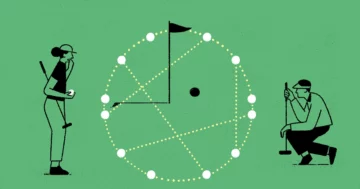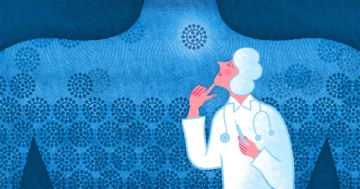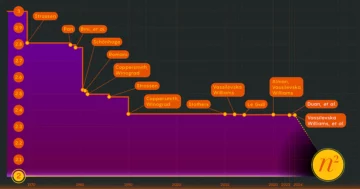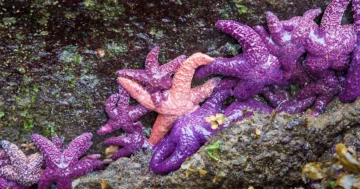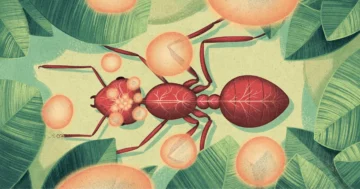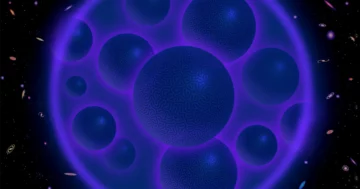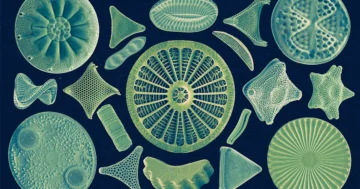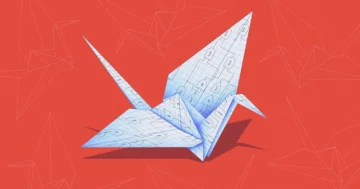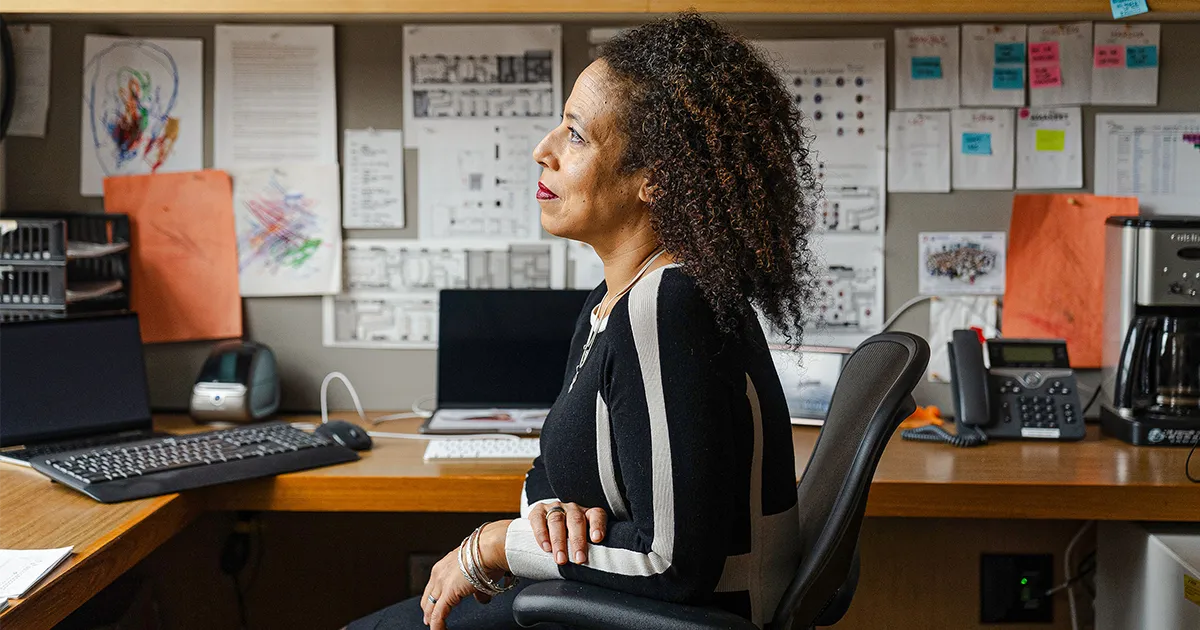
Introduction
In Cassandra Extavour’s office at Harvard University hangs a placard with a painted rainbow flag and a friendly invitation.
“You are welcome here,” it reads.
“I have it up because I think it’s important to let people see your identities, especially when those identities are not well represented,” explained Extavour, an evolutionary geneticist who in 2014 became the first Black woman to win tenure in the biological sciences at Harvard’s Faculty of Arts and Sciences.
Extavour herself has multiple identities, both professionally and personally, enough to qualify as a true Renaissance woman. She is a Howard Hughes Medical Institute investigator, but also a classically trained soprano who performs with the Boston Landmarks Orchestra and the Handel and Haydn Society.
Beyond teaching and singing, Extavour researches the biochemistry and genetics of the earliest life on earth. She wants to know how the first cells developed and eventually evolved into multicellular organisms. What cellular mechanisms made complex life possible? she asks. More specifically, what special influence might germ cells — which make eggs or sperm, passing genetic information from parents to offspring — have had in the development of multicellular life?
Her laboratory work, which combines experimentation and advanced mathematics, has won her widespread notice among evolutionary biologists.
In her 2000 doctoral dissertation, Extavour showed that germ cells compete for the chance to bring their information to the next generation. In her lab at Harvard, she has shown that bacteria played a role in creating the genes that were important for establishing germ cell lines in larger, more complex life. Most recently, while studying the eggs of insects, Extavour and her team overturned a widely held assumption about what drives the great diversity in cellular shapes.
“I’m very curious about the origins of multicellular life on Earth,” Extavour explained in a recent Zoom interview from her office in Cambridge. “I know I’ll never see it. But I think a lot about it.”
Quanta spoke with her in three separate interviews in the late fall. The interviews have been condensed and edited for clarity.
Introduction
Since your research is focused on beginnings, let’s start with yours. Where did you grow up?
Toronto, in what was then a working-class neighborhood called the Annex. It was occupied almost entirely by immigrant families from all over the world.
Were you one of those children who always knew they wanted to grow up to become a scientist?
No. I imagined I would be a musician. Or perhaps a dancer. I played the steel drums from the time I was 4. I could read music at a very young age. I took up wind instruments in elementary school. Later on, I studied voice.
There was just a lot of music in my childhood. My father, an immigrant from Trinidad, supported the family as a technician at the CBC, the Canadian Broadcasting Company. But he was also a professional musician. He held concerts regularly. I performed with him.
Within the family, there was the feeling that my siblings and I could do anything we set our minds to — be it mastering a new instrument or gaining admission to the best high school in town. If I expressed an interest in something, the response was, “Go to the library, learn everything about it and make a plan.”
Your family sounds remarkable.
The family story was that we were people from humble origins, but talented, forceful and incredibly creative.
We were definitely raised with the idea that we were different, special, but others might not recognize that. Our parents taught us, “The world isn’t going to always value you for who you are. Don’t let that stop you from living the best life you can.”
Was it challenging to grow up in an interracial family in 1970s Canada?
From an early age, I understood that a lot of people didn’t like the fact that my father was Black and my mother was white. My mother’s family were not excited that she’d married a Black man and had four Black children. It took them time to accept it.
In retrospect, I’ve come to realize that our family’s outsideness gave me many useful tools. For instance, I knew from an early age that the outside world might be hostile to me, and so I couldn’t count on it for accurate feedback. I got a lot of early practice in deciding for myself if something was good or bad — or interesting. That’s a tremendous asset when you’re designing experiments.
Introduction
Given your early interest in performing, how did an interest in genetics come into your life?
Completely by accident. In my first year of college, at the University of Toronto, I found myself in a situation where I quickly needed to pick a major. I was singing in a chorus at the time, and I asked the neighbor sitting next to me what hers was. “Genetics,” she said. It was a completely random decision.
But a fortunate one?
Yes. Because genetics majors were required to take biochemistry. I had previously taken biology classes, but I found them — at least the way they were taught — to be a disconnected list of things to memorize.
Biochemistry, on the other hand, was an exciting logic puzzle. There were all these different parts — proteins, mitochondria, genes — and they all worked together to make a cell that would do stuff. The game was to figure out how the pieces worked together. I found that totally engaging.
Now, I hadn’t grown up in an academic environment. I didn’t know anything about research careers, or that the job that I have today even existed.
But I asked around school and one of the older students told me, “If you want to do serious genetics, you’ll need to go to graduate school and get a doctorate.”
You chose to do your graduate studies in Europe. Why there?
I picked the Autonomous University of Madrid because I wanted to become fluent in Spanish and because I wanted to study with Antonio García-Bellido, one of the preeminent developmental geneticists of the 20th century. When I read his papers, he seemed to think about development in a way that no one else did.
In thinking about that decision later on, in hindsight it seemed like a wise choice for another reason. If I had done my graduate work in the United States, which I was encouraged to do, that would have made graduate school more difficult than it already was. In the U.S. you feel the constant onslaught of racial division.
The doctoral dissertation you produced under García-Bellido, about selection in the germline of the fruit fly, had a huge impact on developmental genetics. Why was it such a blockbuster?
Because I provided direct experimental evidence for something that had long been hypothesized, but not previously shown. Namely, that just as whole animals can be subject to natural selection, where the fit survives better than the less fit, individual germ cells within a developing animal can do the same thing.
Germ cells are fascinating because they are a special novelty of multicellular organisms. Almost every major successful multicellular life form reproduces with germ cells. They are how genes get passed down from one generation to another. They are what provides the ability for cells to stick together, or to form a big multicellular conglomerate like a banana or a person.
Introduction
So you proved that the germ cells within the fruit flies were competing. But in what way? What was the nature of their competition?
Because of mutations that arise spontaneously in tissues, the different germ cells in an organism can have slightly different genes. Those mutations can affect how well the germ cells grow and produce successful eggs or sperm, which puts them in competition with respect to natural selection. But it turns out that many of those same genes also affect developmental processes throughout the rest of the body. So this selection process among the germ cells can have major effects on the health and fitness of the produced offspring throughout their lives.
Your dissertation had strong implications for evolutionary biology, did it not?
It did. Understanding how you evolve a genetic program to make that tiny subset of reproductive cells is really important.
Much of my subsequent career has been guided by wanting to understand how a single cell, the fertilized egg, creates a complex multicellular adult made of millions of cells. I’m trying to figure out how the different types of cells in organisms first arose.
Among the questions I’m asking is: How do they know what to do? What genes do they use to do this? And since the first life on Earth was single-celled, how did multicellular genes and cell types evolve in the first place?
What became of your musical interests while you tried to understand germ cells?
All along the way, I found ways to do both science and music. While working in Madrid and later when I did a postdoc at Cambridge in the U.K., I still studied voice. Moreover, I attended auditions and performed in shows on weekends.
While I worked on my doctorate and during my postdoc, my voice teacher was in Switzerland. He had other students in Madrid, and he’d come to Spain every six weeks or so to work with us. Sometimes, I’d fly to Basel for lessons. I’d record his lessons and study them afterward.
Of course, there were moments when these two interests were at odds. After I finished my doctorate, my voice teacher urged me to devote myself full time to singing. “You’re 26 now,” he said. “It’s time to get serious about your voice. It’s now or never.”
I considered his argument. But I had this great interest in biology. At the end of the day, I had to find a way to do both.
Fortunately, as both a graduate student and a postdoc, I had very senior principal investigators who gave me a lot of independence. As long as I did the work at the expected high level, I could make my own schedule.
That might mean spending a few extra nights in the lab getting the fruit flies into shape because I wouldn’t be able to tend to them while on tour with a show. Or carrying the flies with me in my bag so that I didn’t have to stop an experiment.
Introduction
You did your postdoc with the zoologist Michael Akam at Cambridge. In an era when biochemistry predominates, the study of whole animals can sometimes seem like a throwback to another century. Why did you choose it?
Because I wanted to take the findings in my dissertation to the next step. The dissertation examined how germ cells behaved in one animal. At Cambridge, I asked how germ cells behaved in all animals and how they evolved. To do that, I studied sea urchins, crustaceans and sea anemones in the lab. Then I read the historic literature, just about everything published on the germ cells of hundreds of different species.
Throughout my career, I’ve tried to build on previous findings, and that sometimes means going outside of the original discipline or stretching its definitions. Right now, in my lab, we’re trying to understand the evolution of development by considering more than genes.
We are incorporating ecology and environment into our studies. Instead of just studying fruit flies in isolation, we are looking at the microbes that live inside the flies and the plants that the flies feed on. With this work, we hope to understand how the developmental processes can evolve in real-life environments.
What would you say are the most important findings to come from your Harvard lab?
First, showing that cell-cell signaling is not an unusual way for animals to generate embryonic germ cells — that is, cells that will become eggs and sperm. The idea that dominated textbooks for most of the 20th century was that in insects and most other animals, a “germ plasm” in the egg established a distinct lineage of germ cells very early in development. But we showed that in crickets, body cells are induced to change into germ cells by signals from the surrounding tissues. That’s what happens in mice and other mammals, too, but it was thought to be a novel mechanism that appeared rarely in evolution.
Second, discovering in 2020 that the long-lost relatives of oskar, a gene very famous for its essential role in insect reproduction, were actually from bacteria, not just from earlier animals. This gene evolved by fusion of bacterial genome sequences with animal genome sequences. It suggests that the forerunners to oskar had very different functions, possibly in the development of the nervous system, and that further study of how it evolved its new purpose could be highly informative.
Third, falsifying century-old “laws” that predicted the shapes of biological structures. Insect eggs vary tremendously, by eight orders of magnitude in size and with wildly different shapes. Previous assumptions were that a universal “law” of some kind, that applied to all animals, could explain the evolution of the shapes and sizes of cells and of structures made of cells. In the case of eggs, there were many previous hypotheses about what these laws were, including, for example, that the dimensions of the eggs reflected the requirements of the developmental rate or the adult body size for each species.
But we constructed an unparalleled data set of over 10,000 measurements of insect eggs and found that what really best predicted the size and shape of an egg was where it would be laid. Eggs laid on the ground or under leaves are basically elliptical. Eggs laid in the water tend to be smaller and more spherical. Parasitoid eggs laid inside other insects are also small but asymmetrical.
How did you come to move your work from Cambridge to Harvard?
In 2003, Harvard invited me to give a seminar. Afterward, people said, “Do you know that there’s an assistant professorship opening in evolutionary developmental biology? You should apply.”
I was perfectly happy at Cambridge. I had just gotten four years’ worth of funding for research. Frankly, I didn’t think I’d get the job because I had a pretty clear idea of what Harvard was looking for and it didn’t look like me. I was surprised to receive an offer.
Within a few years, you won tenure. In fact, you became the first Black woman to be tenured in the biological sciences at Harvard’s Faculty of Arts and Sciences. Did that feel good — or like a burden?
Both. Listen, this was not the first time in my life that I’ve been a “first.” Being the only Black woman in an all-white environment is essentially the story of my professional life. My chosen field of work is predominantly white. Often, whenever I do anything professionally, I’m the first Black woman to have done it. That’s not a reflection on me. That’s a reflection on the field.
Have you experienced any bias at Harvard?
I have not experienced a huge amount of deliberate blockage or targeted discrimination. But things often happen. I’ll turn up at the door for something and am told to use the service entrance. “Oh, I’m here for the [Harvard] Corporation dinner,” I explain. “Oh yes, the service entrance is around the back.”
Or I’m the keynote speaker at a conference. I’ll go to the front desk and hear, “Are you waiting for someone?”
It’s so constant. Saying that we should react like “it’s water off a duck’s back” implies that there’s no residue left behind. There’s a huge buildup of scar tissue. I can’t use my brain space to hold every single one of those because I need my brain space to do other things.
Introduction
It’s well known that relatively few Black Americans are studying for advanced degrees in the STEM disciplines. They are 14% of the population and yet only 7% of the doctoral students in science and engineering. Based on what you’ve witnessed, why is there such a disparity?
One reason is because the experimental and the theoretical sciences are, for the most part, founded on an apprenticeship or gatekeeper model. One gains access to a career through a mentor or an adviser. The trainers choose trainees whom they identify with. If the gatekeepers are of a certain group, they perpetuate that group.
Are you able to use your position to support minoritized students interested in science careers?
I do my best to show up for them. I prioritize talking to minoritized students when they need it. For the minoritized students, it’s important to provide a positive presence and a willing ear.
That said, I show up for all of my students. For the students in the majority, I am often the first Black professor they’ve ever had. It’s important for them to know me.
About the other part of your life — music. Does your music feed your science at all?
I wouldn’t say that — though when I’m singing, my brain and body do get a break from science.
And vice versa. Both pursuits are extremely demanding and absorbing in different ways. Changing activities gives part of me a chance to rest and refuel and mull over things in the subconscious while I’m engaged with something else. The subconscious things can come back to the surface when I return.
Where there is, perhaps, some overlap is in the reality that they are both creative problem-solving enterprises. In art, you have something to communicate. You choose the medium. You try to perfect your expression of it, and you go out and do it. In science, you gather up your resources, answer a question and communicate it to the world. In that way, they are somewhat similar.
You performed in December at Lincoln Center in New York as part of an ensemble presenting Handel’s Messiah. How do you prepare for such a performance?
To be honest with you, I imagine success. While we’re waiting backstage for our entrance, I’m seeing in my mind the end of the show and the applause. I imagine standing ovations and seeing the people in the front row with looks of delight on their faces. I imagine myself during the performance: feeling free, feeling filled with the music, feeling that my body is a vessel for the communication of the music.
Do you ever feel regret that when you had the chance, you didn’t move to Switzerland and pursue music full time?
No. The science was a choice that has led me to an amazing and exciting career: I get to spend most of my time trying to understand the origins of multicellular life and of germ cells, and it’s actually my paid job to do this! I want to keep choosing this. It’s super interesting and fun.
- SEO Powered Content & PR Distribution. Get Amplified Today.
- PlatoData.Network Vertical Generative Ai. Empower Yourself. Access Here.
- PlatoAiStream. Web3 Intelligence. Knowledge Amplified. Access Here.
- PlatoESG. Carbon, CleanTech, Energy, Environment, Solar, Waste Management. Access Here.
- PlatoHealth. Biotech and Clinical Trials Intelligence. Access Here.
- Source: https://www.quantamagazine.org/a-multitalented-scientist-seeks-the-origins-of-multicellularity-20240221/
- :has
- :is
- :not
- :where
- ][p
- $UP
- 000
- 10
- 2000
- 2014
- 2020
- 20th
- 26
- 4
- a
- ability
- Able
- About
- about IT
- AC
- academic
- Accept
- access
- accident
- accurate
- activities
- actually
- Adult
- advanced
- adviser
- affect
- After
- age
- All
- almost
- along
- already
- also
- always
- am
- amazing
- Americans
- among
- amount
- an
- and
- animal
- animals
- Annex
- Another
- answer
- any
- anything
- appeared
- Applause
- applied
- Apply
- ARE
- argument
- arise
- around
- Art
- Arts
- AS
- asked
- asking
- asset
- Assistant
- assumption
- assumptions
- At
- autonomous
- back
- Backstage
- Bacteria
- Bad
- bag
- Banana
- based
- Basel
- Basically
- BE
- became
- because
- become
- been
- behind
- being
- BEST
- Better
- bias
- Big
- biology
- Black
- blockbuster
- body
- boston
- both
- Brain
- Break
- bring
- Broadcasting
- build
- burden
- but
- by
- called
- cambridge
- CAN
- Canada
- Canadian
- Career
- careers
- carrying
- case
- cell
- Cells
- cellular
- Center
- Century
- certain
- challenging
- Chance
- change
- changing
- Children
- choice
- Choose
- choosing
- chose
- chosen
- clarity
- classes
- clear
- College
- combines
- come
- communicate
- Communication
- company
- compete
- competing
- competition
- completely
- complex
- concerts
- Conference
- conglomerate
- considered
- considering
- constant
- constructed
- CORPORATION
- could
- count
- course
- creates
- Creating
- Creative
- curious
- data
- day
- December
- Deciding
- decision
- definitely
- definitions
- delight
- demanding
- designing
- desk
- developed
- developing
- Development
- developmental
- DID
- different
- difficult
- dimensions
- Dinner
- direct
- discipline
- disciplines
- disconnected
- discovering
- Discrimination
- disparity
- distinct
- Diversity
- Division
- do
- does
- dominated
- done
- Dont
- Door
- down
- drives
- drums
- during
- each
- Earlier
- earliest
- Early
- earth
- edited
- effects
- Eggs
- eight
- elementary
- else
- encouraged
- end
- engaged
- engaging
- Engineering
- enough
- enterprises
- entirely
- entrance
- Environment
- environments
- Era
- especially
- essential
- essentially
- established
- establishing
- Europe
- Even
- eventually
- EVER
- Every
- everything
- evidence
- evolution
- evolve
- evolved
- example
- excited
- exciting
- existed
- expected
- experienced
- experiment
- experimental
- experiments
- Explain
- explained
- expressed
- expression
- extra
- extremely
- faces
- fact
- Fall
- families
- family
- famous
- fascinating
- feedback
- feel
- feeling
- few
- field
- Figure
- filled
- Find
- findings
- finished
- First
- first time
- fit
- fitness
- focused
- For
- form
- fortunate
- found
- Founded
- four
- Free
- friendly
- from
- front
- full
- fun
- functions
- funding
- further
- fusion
- gaining
- Gains
- game
- gather
- gave
- generation
- genetic
- Genetics
- genome
- get
- getting
- Give
- gives
- Go
- going
- good
- got
- graduate
- great
- Ground
- Group
- Grow
- grown
- guided
- had
- hand
- hangs
- happen
- happens
- happy
- harvard
- harvard university
- Have
- he
- Health
- hear
- Held
- her
- here
- High
- highly
- him
- hindsight
- his
- historic
- hold
- honest
- hope
- hostile
- How
- howard
- HTML
- HTTPS
- huge
- humble
- Hundreds
- i
- I’LL
- idea
- identify
- identities
- if
- imagine
- imagined
- Impact
- implications
- implies
- important
- in
- Including
- incorporating
- incredibly
- independence
- individual
- influence
- information
- informative
- inside
- instance
- instead
- Institute
- instrument
- instruments
- interest
- interested
- interesting
- interests
- Interview
- Interviews
- into
- Investigators
- invitation
- invited
- isolation
- IT
- ITS
- Job
- just
- Keep
- Keynote
- Keynote Speaker
- Kind
- knew
- Know
- known
- lab
- laboratory
- laid
- landmarks
- larger
- Late
- later
- Laws
- LEARN
- least
- Led
- left
- less
- Lessons
- let
- Level
- Library
- Life
- like
- Lincoln
- lineage
- lines
- List
- listen
- literature
- live
- Lives
- living
- logic
- Long
- Look
- look like
- looking
- LOOKS
- Lot
- made
- magazine
- magnitude
- major
- Majority
- Majors
- make
- man
- many
- Mastering
- mathematics
- me
- mean
- means
- measurements
- mechanism
- mechanisms
- medical
- medium
- mentor
- mice
- might
- millions
- mind
- minds
- Mitochondria
- model
- Moments
- more
- Moreover
- most
- mother
- move
- multiple
- Music
- musical
- Musician
- my
- myself
- namely
- Natural
- Nature
- Need
- needed
- never
- New
- New York
- next
- no
- Notice..
- novel
- novelty
- now
- Odds
- of
- off
- offer
- Office
- often
- older
- on
- ONE
- only
- onslaught
- opening
- or
- orders
- organisms
- original
- origins
- Other
- Others
- our
- out
- outside
- over
- overlap
- own
- paid
- papers
- parents
- part
- parts
- passed
- Passing
- People
- perfect
- perfectly
- performance
- performed
- performing
- performs
- perhaps
- perpetuate
- person
- Personally
- pick
- picked
- pieces
- Place
- plan
- plants
- plato
- Plato Data Intelligence
- PlatoData
- played
- population
- position
- positive
- possibly
- practice
- predicted
- predominantly
- preeminent
- Prepare
- presence
- presenting
- pretty
- previous
- previously
- Principal
- Prioritize
- problem-solving
- process
- processes
- produce
- Produced
- professional
- professionally
- Professor
- Program
- Proteins
- proved
- provide
- provided
- provides
- published
- purpose
- pursue
- Puts
- puzzle
- qualify
- Quantamagazine
- question
- Questions
- quickly
- raised
- random
- rarely
- Rate
- React
- Read
- Reality
- realize
- really
- reason
- receive
- recent
- recently
- recognize
- record
- reflected
- reflection
- regret
- regularly
- relatively
- relatives
- remarkable
- Renaissance
- represented
- reproduction
- required
- Requirements
- research
- researches
- Resources
- respect
- response
- REST
- return
- right
- Role
- ROW
- s
- Said
- same
- say
- saying
- scar
- schedule
- School
- Science
- SCIENCES
- Scientist
- SEA
- see
- seeing
- Seeks
- seem
- seemed
- selection
- seminar
- senior
- separate
- serious
- service
- set
- Shape
- shapes
- she
- should
- show
- showed
- showing
- shown
- Shows
- signals
- similar
- since
- single
- Sitting
- situation
- SIX
- Size
- sizes
- slightly
- slightly different
- small
- smaller
- So
- Society
- some
- Someone
- something
- sometimes
- somewhat
- sounds
- Space
- Spain
- Spanish
- Speaker
- special
- specifically
- spend
- Spending
- sperm
- standing
- start
- States
- steel
- Stem
- Step
- Stick
- Still
- Stop
- Story
- strong
- structures
- Student
- Students
- studied
- studies
- Study
- Studying
- stuff
- subject
- subsequent
- success
- successful
- such
- Suggests
- Super
- support
- Supported
- Surface
- surprised
- Surrounding
- switzerland
- system
- Take
- taken
- talented
- talking
- targeted
- taught
- teacher
- Teaching
- team
- tend
- textbooks
- than
- that
- The
- the world
- their
- Them
- then
- theoretical
- There.
- These
- they
- thing
- things
- Think
- Thinking
- this
- those
- though?
- thought
- three
- Through
- throughout
- time
- tiny
- tissue
- tissues
- to
- today
- together
- told
- too
- took
- tools
- toronto
- TOTALLY
- Tour
- town
- trained
- tremendous
- tremendously
- tried
- Trinidad
- true
- try
- trying
- TURN
- turns
- two
- types
- U.K.
- u.s.
- under
- understand
- understanding
- understood
- United
- United States
- Universal
- university
- unparalleled
- unusual
- urged
- us
- use
- useful
- value
- vary
- versa
- very
- Vessel
- vice
- Voice
- Waiting
- want
- wanted
- wanting
- wants
- was
- Water
- Way..
- ways
- we
- webp
- Weeks
- welcome
- WELL
- were
- What
- when
- whenever
- which
- while
- white
- WHO
- whole
- whom
- why
- widely
- widespread
- wildly
- will
- willing
- win
- wind
- WISE
- with
- within
- witnessed
- woman
- Won
- Work
- worked
- working
- world
- worth
- would
- year
- years
- yes
- yet
- york
- you
- young
- Your
- yours
- zephyrnet
- ZOO
- zoom


